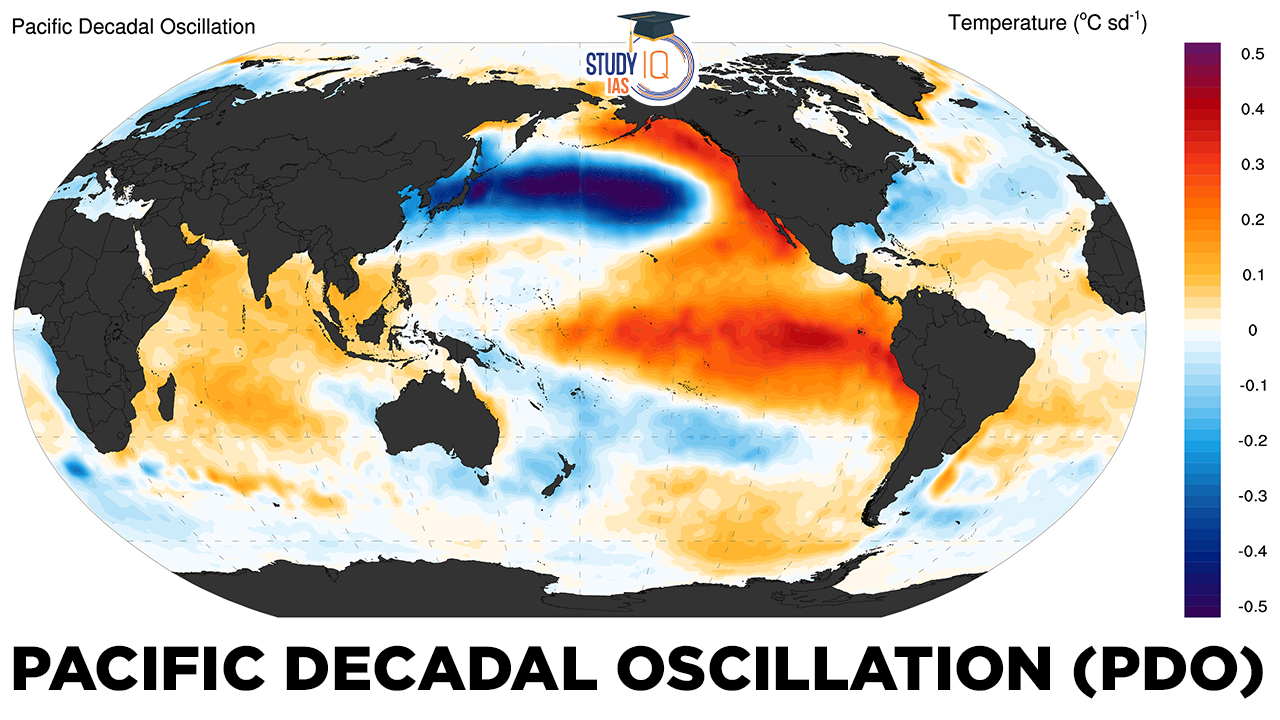Table of Contents
Context: A study published in the journal Nature Communications suggests that a combination of global warming and a cyclical phenomenon called the Pacific Decadal Oscillation (PDO) could make equatorial-origin tropical cyclones more frequent in the coming years.
More on the News
- Majority of the tropical cyclones generally form around the equator at 5 ° – 30 °.
- However, tropical cyclones generally do not form on the Equator or in the area that is located within five degrees of latitude from the Equator because the Coriolis forces at the equator are too small to generate a vortex powerful enough to form a cyclone.
- According to the study, the Pacific Decadal Oscillation (PDO) can influence low-latitude cyclones by increasing low-level vorticity, thereby aiding cyclone genesis.
- Cyclones are generally rare to form near the equator, but when the waters warm, they can gain more moisture and increase in intensity, the study noted.
- Between 1981-2010, equatorial-origin cyclones decreased by 43% compared to 1951-1980 due to the ‘warmer’ positive phase of PDO.
What is the Pacific Decadal Oscillation?
- The Pacific Decadal Oscillation (PDO) is a long-term climate pattern that affects the temperature of the Pacific Ocean and the weather patterns around it.
- The PDO is a naturally occurring phenomenon that shifts between warm and cool phases, with each phase lasting around 20-30 years.
- The Pacific Decadal Oscillation can strongly impact global weather and is important in long-range weather forecasting.
Phases of Pacific Decadal Oscillation
Positive Phase (Warm Phase):
- During the positive phase of the PDO, the sea surface temperatures in the central and eastern Pacific are warmer than average, while the western Pacific tends to be cooler.
- A ‘warm’ phase of PDO occurred from 1977 to 1999 (22 years).
- This warmer-than-normal condition can lead to various effects on weather and climate, such as:
- Increased likelihood of wetter and cooler conditions along the western coast of North America.
- Warmer and drier conditions in the western Pacific, including Australia and parts of Asia.
- Altered atmospheric circulation patterns, affecting storm tracks and precipitation patterns.

Negative Phase (Cool Phase):
- During the negative phase of the PDO, the sea surface temperatures in the central and eastern Pacific are cooler than average, while the western Pacific is relatively warmer.
- A ‘cool’ phase of PDO occurred from 1947 to 1976 (29 years).
- This phase also has significant impacts on weather and climate:
- Increased likelihood of drier and warmer conditions along the western coast of North America.
- Cooler and wetter conditions in the western Pacific, affecting regions like Australia and parts of Asia.
- As of May 2023, the Pacific Decadal Oscillation is in a negative phase. It began in late 2019 and has remained in a negative phase for approximately 2.5 years.
Causes of PDO
- The cause of changes in the PDO has yet to be identified and it may even be due to a combination of factors including:
- long-lasting fingerprints of El Nino and La Nina events in the tropical Pacific Ocean;
- changes in atmospheric pressure the northern Pacific;
- the impact of industrial pollution; and
- natural variability.
PDO and ENSO
- Both ENSO and the PDO are important sea surface-based phenomena that influence weather conditions in the Pacific basin.
- Time scale: PDO is a pattern of Pacific climate variability similar to El Nino-Southern Oscillation (ENSO) in character, but which varies over a much longer time scale.
- The PDO can remain in the same phase for 20 to 30 years, while ENSO cycles typically only last 6 to 18 months.
- Impact of PDO on ENSO: PDO can intensify or diminish the impacts of ENSO according to its phase.
- If both ENSO and the PDO are in the same phase, it is believed that El Niño/La Nina impacts may be magnified.
- Conversely, if ENSO and the PDO are out of phase, it has been proposed that they may offset one another, preventing “true” ENSO impacts from occurring.
About El Niño–Southern Oscillation (ENSO)
- The ENSO is a recurring climate pattern involving changes in the temperature of waters in the central and eastern tropical Pacific Ocean.
- On periods ranging from about three to seven years, the surface waters across a large swath of the tropical Pacific Ocean warm or cool by anywhere from 1°C to 3°C, compared to normal.
- This oscillating warming and cooling pattern, referred to as the ENSO cycle, directly affects rainfall distribution in the tropics and can have a strong influence on weather across the world.
- ENSO has three phases: El Niño, La Niña, and neutral, which are associated with different temperature and atmospheric conditions.
- El Niño occurs when the surface water temperature in the eastern Pacific Ocean becomes warmer than usual, and this warming can last for several months to a few years.
- La Niña occurs when the surface water temperature in the eastern Pacific Ocean becomes cooler than usual, and this cooling can also last for several months to a few years.
- Neutral conditions occur when the sea surface temperatures in the eastern Pacific Ocean are close to average, with no significant warming or cooling.
Difference between El Niño and La Niña
El Niño v/s La Niña

| Basis of comparison | El Niño | La Niña |
| Meaning | El Niño means Little Boy, or Christ Child in Spanish. | La Niña means Little Girl in Spanish. |
| Sea surface temperature | It represents the above-average sea-surface temperatures that periodically develop across the east-central equatorial Pacific. | It represents the periodic cooling of sea-surface temperatures across the east-central equatorial Pacific. |
| Pressure | It is laden with high air surface pressure in the western Pacific. | It contain low air surface pressure in the eastern Pacific |
| Mechanism | During El Niño, trade winds weaken. Warm water is pushed back east, toward the west coast of the Americas, resulting in a weaker Walker cell. | During La Niña events, trade winds are even stronger than usual, pushing more warm water toward Asia, resulting in a stronger Walker cell. |
| Period of occurence | Typically occure every 3-5 years and lasts 9-12 months. | Typically occur every 3-5 years and lasts 1-3 years. |
| Impacts | Droughts in eastern Australia
Flooding in western South America Weak upwelling over the west coast of South America. |
Excessive rainfall in the eastern Australia
Drought conditions prevail in the South America Strong upwelling over the west coast of South America. |
| Impact on Indian Monsoon | The monsoon is affected so heavily that 70% reduction of the rainfall is expected. The winds doesn’t carry the moisture towards Indian landmass during El Nino causing deficiency in rainfall. | La Nina causes high temperatures over the Indian Ocean, off the Somalian coast and a comparatively better monsoon rains in India. |


 Daily Quiz 05 July 2025
Daily Quiz 05 July 2025
 SSC MTS Apply Online for 1075 Posts – ...
SSC MTS Apply Online for 1075 Posts – ...
 Dynamic Pricing: What It Is and Why It's...
Dynamic Pricing: What It Is and Why It's...





















